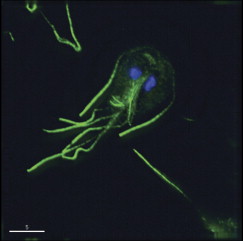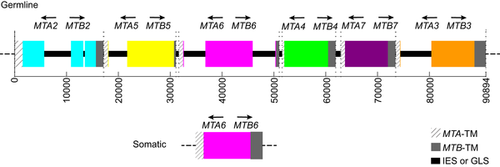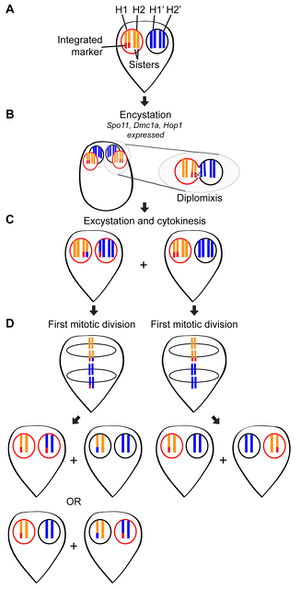Sexual Reproduction of Pathogenic Eukaryotes: Difference between revisions
No edit summary |
|||
| Line 3: | Line 3: | ||
Eukaryotic microbes do not simply reproduce through binary fission as bacteria do; rather, a large number of eukaryotic microbes undergo some form of sexual reproduction. Sex appears to be ubiquitous among larger eukaryotes, but its presence among the smaller, unicellular organisms is yet to be determined. Discovering sexual reproduction in eukaryotic microbes presents its own host of problems due to the fact that microbial sex is often rare, furtive, or cryptic [1]. Rare because many microbes reproduce in a sexual manner rarely and asexually commonly, furtive because many times sexual reproduction occurs under conditions which cannot be seen, or cryptic meaning that it can be observed but difficult to recognize what is going on [1]. Sexual reproduction is defined as any process in which chromosomes from two different cells, or two nuclei from the same cell, combine into a single nucleus and undergo homologous recombination to create a new genome [1, 2]. Sexual reproduction allows alleles to reassert, increasing genetic diversity and the removal of mutations, eventually resulting in progeny better fit to the environment [3].<br> | Eukaryotic microbes do not simply reproduce through binary fission as bacteria do; rather, a large number of eukaryotic microbes undergo some form of sexual reproduction. Sex appears to be ubiquitous among larger eukaryotes, but its presence among the smaller, unicellular organisms is yet to be determined. Discovering sexual reproduction in eukaryotic microbes presents its own host of problems due to the fact that microbial sex is often rare, furtive, or cryptic [1]. Rare because many microbes reproduce in a sexual manner rarely and asexually commonly, furtive because many times sexual reproduction occurs under conditions which cannot be seen, or cryptic meaning that it can be observed but difficult to recognize what is going on [1]. Sexual reproduction is defined as any process in which chromosomes from two different cells, or two nuclei from the same cell, combine into a single nucleus and undergo homologous recombination to create a new genome [1, 2]. Sexual reproduction allows alleles to reassert, increasing genetic diversity and the removal of mutations, eventually resulting in progeny better fit to the environment [3].<br> | ||
Two modes of sexual reproduction exist in eukaryotic microbes: meiotic sex and parasexual cycles [1]. Meiotic sex is the reduction of a diploid cell to a haploid state and the eventual unification of two haploid cells to create a diploid zygote. A parasexual cycle begins with the fusion of two haploid cells and the fusion of the nuclei to create one diploid nucleus, where homologous recombination occurs. However, the diploid nucleus soon becomes unstable and loses random chromosomes, re-forming a haploid cell. Additionally, sexual reproduction can be either obligate or facultative [4]. A wide variety of eukaryotic microbes undergo sexual reproduction; however, research has centered around pathogenic eukaryotes due to the fact that parasitic reproduction can have a large effect upon the effectiveness of vaccines and treatment plans [1,5].<br> | |||
==Finding Evidence for Sexual Reproduction== | ==Finding Evidence for Sexual Reproduction== | ||
Revision as of 19:09, 24 April 2013
Overview
Eukaryotic microbes do not simply reproduce through binary fission as bacteria do; rather, a large number of eukaryotic microbes undergo some form of sexual reproduction. Sex appears to be ubiquitous among larger eukaryotes, but its presence among the smaller, unicellular organisms is yet to be determined. Discovering sexual reproduction in eukaryotic microbes presents its own host of problems due to the fact that microbial sex is often rare, furtive, or cryptic [1]. Rare because many microbes reproduce in a sexual manner rarely and asexually commonly, furtive because many times sexual reproduction occurs under conditions which cannot be seen, or cryptic meaning that it can be observed but difficult to recognize what is going on [1]. Sexual reproduction is defined as any process in which chromosomes from two different cells, or two nuclei from the same cell, combine into a single nucleus and undergo homologous recombination to create a new genome [1, 2]. Sexual reproduction allows alleles to reassert, increasing genetic diversity and the removal of mutations, eventually resulting in progeny better fit to the environment [3].
Two modes of sexual reproduction exist in eukaryotic microbes: meiotic sex and parasexual cycles [1]. Meiotic sex is the reduction of a diploid cell to a haploid state and the eventual unification of two haploid cells to create a diploid zygote. A parasexual cycle begins with the fusion of two haploid cells and the fusion of the nuclei to create one diploid nucleus, where homologous recombination occurs. However, the diploid nucleus soon becomes unstable and loses random chromosomes, re-forming a haploid cell. Additionally, sexual reproduction can be either obligate or facultative [4]. A wide variety of eukaryotic microbes undergo sexual reproduction; however, research has centered around pathogenic eukaryotes due to the fact that parasitic reproduction can have a large effect upon the effectiveness of vaccines and treatment plans [1,5].
Finding Evidence for Sexual Reproduction
Mating Type Locus (MAT)
Meiosis Genes
Double Peaks
Population Genetics
Evolution of Sexual Reproduction
Examples of Sexual Reproduction in Eukaryotic Microbes
Candida albicans
Giardias



